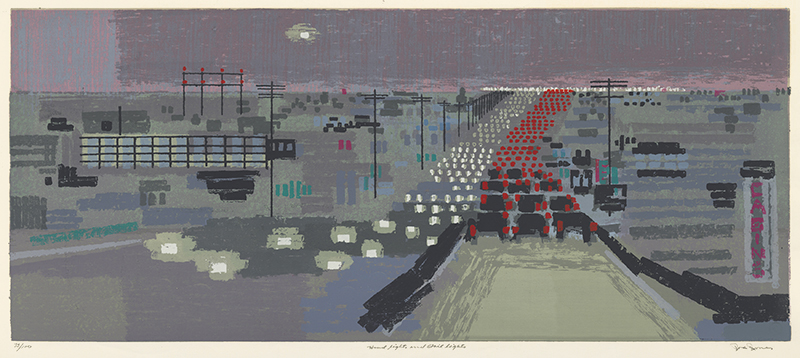Head Lights and Tail Lights is an original color screenprint (serigraph) created in 1960 by American artist, Joe Jones. It is pencil signed, titled and editioned 73/100. Head Lights and Tail Lights was published by Associated American Artists and the reference is AAA 1340. It was printed by the artist on ivory wove paper and the image measures 14-1/2 x 34 inches.
Head Lights and Tail Lights is based upon an oil on canvas of the same subject that was included in the 1954 exhibition Twenty-Nine Modern American Painters at the Montclair Art Museum in Montclair, New Jersey. The painting is illustrated as a banner for a review of the exhibition (a clipping is in the archives of the Newark Public Library but its source is not identified). According to this article the subject of this painting was in dispute: “Is it Route 3 or the New Jersey Turnpike?...There are two schools of thought on the question, depending on which side of the Hudson you live. The New York gallery, which loaned the painting for the exhibition, states it’s the Jersey Turnpike. Visitors this week claim it’s Route 3. Joe Jones hasn’t commented. He left, before the question came up, for an extended stay and painting excursion to Bermuda.”
Joe Jones, painter, muralist, printmaker, papermaker, and illustrator, was born Joseph John Jones on 7 April 1909 in St. Louis, Missouri. His family lived on the edge of a slum neighborhood in Saint Louis where his father worked as a house painter. Joe quit school at the age of fifteen-years-old to work with his father. He was basically self-taught as an artist and exhibited his paintings and prints around St. Louis in the late 1920s. At the age of twenty-two he garnered awards for his regionalist paintings.
In 1934, Jones organized art classes for children of unemployed workers at the St. Louis courthouse and signed up for the Public Works of Arts Project under which he created paintings, prints, and murals. This same year, Jones became a member of the Communist party and was a leading political activist throughout the decade of the Great Depression. His views were greatly criticized by mid-western conservatives so Jones departed St. Louis for New York in 1935.
Jones held his first exhibition in New York in 1935, which was acclaimed by poet and critic Archibald MacLeish: “There is more scope, more vitality, and more promise as well as more mastery, than most artists a decade his senior.” In 1937, Jones was awarded a Guggenheim Foundation Fellowship and his art was included in important exhibitions at the Carnegie Institute. During World War II, Jones worked as artist-correspondent for Life Magazine.
By the end of World war II, the majority of Jones's prints were created in the medium of lithography. In 1945, he made his first experiments in the newly invented technique of color silk screen. The possibility within the silk screen process of creating large prints with full ranges of color and tonal value contributed to a transformation of his art. Moving more towards a lyrical, almost calligraphic form of abstractionism, Jones brilliantly explored the relationships of line, form and color.
During his career, Joe Jones's art underwent significant changes. By 1951, for a new show in New York, Time reported the “angry man calms down.” The paintings on exhibit showed “delicately colored, wiry-lined pictures of beaches, towns, and harbors... without a spark of sorrow or anger in them.” At the age of forty-two, Jones did not want to “sit on top of a reputation,” had lost interest in Communism, and removed “class war” from his paintings. He became interested in delicate lines and low-toned colors, a reaction against “the preoccupation with light and shade that has victimized Western art since the Renaissance.” By this time, he saw paintings as “space, not objects” and sought humanism not in subject but “of the line.” By this time, he was residing in Morristown, New Jersey.
By 1952, Time Magazine cited Jones and two other artists as among forty-eight artists whose paintings had been commissioned by Standard Oil of New Jersey. The two other artists were Peter Hurd and Thomas Hart Benton. His early paintings and prints depicting laborers and farm workers were at the forefront of both Social Realism and American Regionalism.
The work of Joe Jones is represented in the collections of the Cleveland Museum of Art, Ohio; the Denver Art Museum, Colorado; the Whitney Museum of American Art, New York; the Walker, Minneapolis, Minnesota; the Saint Louis Art Museum, Missouri; the Library of Congress and the Smithsonian American Art Museum, Washington, D.C.; the Worcester Art Museum, Massachusetts; and the Butler Institute of American Art, Youngstown, Ohio.
Joe Jones died on 9 April 1963 in Morristown, New Jersey. In 2017, a retrospective The Restless Regionalist: The Art of Joe Jones was mounted at the Albrecht-Kemper Museum of Art in St, Joseph, Missouri.



